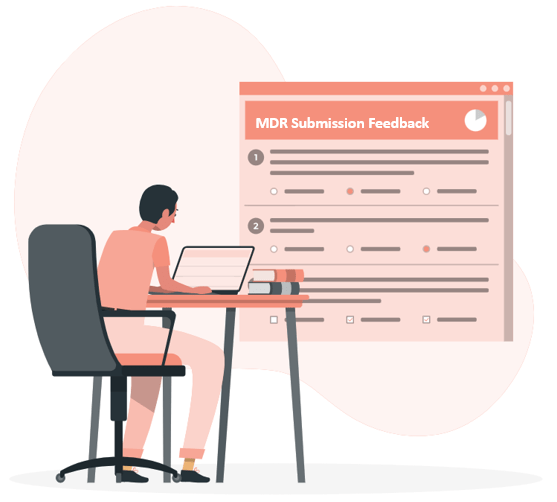Top MDR Submission Feedback
What could delay or risk your EU MDR Technical Document Assessment
Feedback from MDR regulatory submissions are valuable assets that we incorporate in our EU MDR transition projects and strategy documents for clients. In this document we want to share this information and the evolving collective expert knowledge that CLIN-r+ has gathered to support you, the manufacturer, in your MDR submissions.
Here’s what MDR-notified body technical documentation audits have taught us so far.

Stringent Regulations
Manufacturers are discovering that the initial guidance from MDCG and interim notified body review of MDR readiness were not exaggerated when the MDR audit feedback arrives. Compliance, clearly formatted and detailed evidence are expected more than in MDD up until 2020. In addition, the notified bodies anticipate corrections (or in cases complete restructure of Technical Document) to be done in significantly less time than the 6-12 months that were acceptable in prior years (assuming product safety). Many manufacturers are finding it difficult to redo TD against required MDR needs as highlighted by Notified Body and quick timeline changes.
Although it may be appealing to “test the boundaries” by submitting documentation that has technical gaps, notified bodies won’t be accommodating. Since there are only three rounds of review, manufacturers should use feedback effectively.
Technical Documentation Nonconformities
MDR provides the framework for manufacturers’ technical documentation, although an amount is open to interpretation. Notified bodies expect clear, organised, searchable, and unambiguous information per the legislation. Manufacturers have to review their technical documentation packages for all device-specific elements before submitting. Reviewers look at every detail, so prepare your documentation carefully.
Deficiency reports from the notified bodies contain all deficiencies found. Technical documentation deficiencies fall into four areas in our audit findings. We discuss these further below.
1. Device Description and Specification Nonconformities
Details and matching the key required defined terms from the MDR is critical to deliver in a regulatory submission. Notified bodies are thoroughly reviewing device description and specifications.
We have witnessed nonconformities such as:
- Unclear definition of intended use, intended purpose, indication and target patient population.
- No explanation of device history, previous versions, or principle of operation.
- No comprehensive list component compatibility and variants.
- Lack of a bill of materials (BOM) detailing all manufacturing materials, including raw ingredients, packaging, IFUs, labels, and cartons.
- No packaging drawings included in the referenced sections.
- Inclusion of non-applicable standards for the subject device.
- Not referencing the latest version of standards.
2. Testing Nonconformities
Under MDR, product samples equivalent to the finished product must be tested. Manufacturers should carefully assess data selection and product testing strategies and be able to clearly justify them. ISO standards are a a key strategy to prove compliance to the State of the Art to assure safety and performance and should not be regarded a nice to have.
Testing nonconformities reported by notified bodies include:
- Not explaining the selection of a representative worst-case device for biological testing.
- Lack of clarity on whether a representative device has the same material specifications as the subject device under review.
- Not including a comprehensive list of both harmonised and non-harmonised current ISO, ASTM, and other international standards. This includes any applicable to materials, functional testing, packaging, and transport testing, etc that are the current state of the art.
- Omitting applicable harmonised standards in validation testing, can be a very problematic non-conformance and could set back your MDR certificate by 1 year.
- Insufficient product lifetime definition and insufficient validation proof to justify product lifetime.
- Lack of design validation testing for product lifetime.
3. Risk Nonconformities
MDR mandates manufacturers to create, document, implement, and maintain a risk management system that fulfils ISO 14971 Annex I requirements. There are no harmonised standards under EU MDR, however notified bodies consider ISO 14971:2019 to be state of the art and expect compliance.
The manufacturer must have a documented risk management plan. They need to identify and analyse known and foreseeable hazards, estimate, and evaluate risks, and eliminate or control risks for each device. Manufacturers must assess new information and adjust control measures during manufacturing.
Risk-related nonconformities identified by notified bodies include:
- Risk management plans not being provided for each device.
- Missing files in Risk Management File such as RMP, RMA and RMR.
- Not identifying risks synonymous with device category and no justified source of data.
- Risk management assessment missing inputs from clinical evaluation and post-market surveillance.
- Risk management report missing pre-post risk level for device and residual risk statement.
- Missing benefit-risk conclusion in risk management report that matches conclusion in the CER.
- No inclusion of the device in the submitted risk management plan.
- Inadequately addressing risks related to time, process, and clinical use.
- Not addressing the health hazards (adverse events and patient problems).
- No benchmarking of the state of the art to determine the risk range of the device category and alternative treatments for same intended purpose.
Specific clarity on how in the labelling and IFU addresses risks identified during the risk process.

4. Post Market Surveillance Nonconformities
All devices either pre-market or post-market needs a PMS plan. Where a manufacturer has technical documentation that covers multiple device portfolios, each device in that portfolio will need their own PMS plan. All PMs plans need to have reactive and pro-active activities.
Notified bodies found these GSPR nonconformities:
- No PMS plan for each device
- PMS plan does not include proactive PMS activities or PMCF plan to address clinical data gaps.
- PMS plan does not track residual risks or risks that can negatively impact benefit-risk profile (adverse events or device faults pertinent to device category-SoTA).
5.General Safety and Performance Requirement (GSPR) Nonconformities
MDR general safety and performance requirements (GSPR) replace MDD essential requirements. The MDR Annex I requirements have been defined more accurately and in more detail. However, notified body observations tend to focus on applicability justification.
Notified bodies found these GSPR nonconformities:
- Clarity on how specific GSPR sections have been addressed in the technical document.
- Specific clarity on how the labelling and IFU meets GSPR requirements.
- Insufficient explanation on why specific GSPR sections were identified as applicable for the device under review.
- Lack of justification on why specific GSPR sections were identified as not applicable for the devices under review.
Deficiency Reports
Once a deficiency report has been received, the manufacturer has three rounds to close off findings. Take on any opportunities to engage with your notified body to clarify findings.
We are often approached by prospective clients asking if they can restart the process with another notified body if they reach the third round. The answer to this is both yes and no. You can cancel your contract with your current notified body AND engage another auditor at any time. BUT your current notified body is required by EU commission to handover your assessment and your file to the next auditor. Your next auditor is required to maintain the document trail. This means that they will use the handed over material to get an understanding, they will then restart your audit at the point where it was last stopped and continue keeping your file and history of your EU submission.
CLIN-r+ recommendations
Adherence to the EU MDR requirements is the only way to pass the EU MDR assessment. This is not an impossible task, it may be daunting if you do not have the team, resourcing, inhouse expertise or experience. This is where a clinical regulatory affairs consultancy partnership is ideal. Experienced consultants will quickly pick up which skills may be lacking in your team and resources. A consultancy greatly reduces the difficulty by providing compliant Technical Documentation which means after the EU MDR you simply update and maintain the file with significantly less work.
Clin-r+ has expert collective knowledge with extensive and diverse experience across clinical specialties, device classes, and notified bodies.
We offer end to end services from technical documentation creation and submission to help with closing out deficiency reports and audit findings Should you have any questions or need professional assistance, CLIN-r+ has a wealth of experience to call upon. Get in touch!

